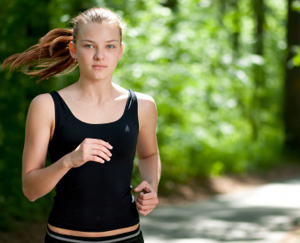Penn Herb Wellness Guide
Teens: Run to Build Bone

Exercise does a body good
Just like the rest of the body, we know that bones need exercise in order to stay in shape. When muscles pull on bones, it causes new bone to be laid down. This happens primarily during weight-bearing exercise, like running or walking. But less is known about the optimal intensity of exercise needed to build a strong skeleton in childhood.
The new study looked at 1,748 adolescents (average age 15.5) to see how different levels of physical activity impacted measures of bone health. The teens wore an electronic motion sensor that measured the frequency and intensity of their movements for seven days. The device was taken off only for bathing or when engaging in water sports, contact sports, and other sports where there was a high risk of falling onto the monitor, such as gymnastics. Based on the readings, average daily minutes of light, moderate, and vigorous physical activity were ascertained. The children also underwent highly sensitive testing to measure bone health, and then relationships between bone health and their level of physical activity were investigated.
Run, don’t walk
Light and moderate physical activity did not appear to improve bone health, whereas vigorous daily exercise correlated with stronger bones. Compared with children in the lowest category of physical activity, those who obtained the most vigorous exercise had significantly more bone in the areas measured. “These results suggest that there is a threshold of intensity below which activity does not affect bone accrual,” said lead study author, Adrian Sayers of the University of Bristol, UK. “Although promotion of walking is an important component of public health campaigns intended to reduce obesity, our results suggest that this activity is unlikely to benefit the skeleton in the young.”
Keeping pace with good health
Maximizing bone health during childhood helps prevent osteoporosis later in life. Here are some tips for growing strong bones.
- Put nutrition first. Aim for foods that are high in bone-building calcium, such as low-fat dairy products, almonds, and broccoli. And don’t forget the vitamin D; what you can’t get safely from the sun in 15 minutes of daily exposure of the hands, forearms, and face, you can make up for with a supplement. Ask your child’s pediatrician about the amount of D that’s right for them.
- Get the right kind of exercise. Look for activities that make your kids run and jump, like basketball, tennis, volleyball, softball, jumping rope, and soccer.
- Start young. Studies have shown that vigorous physical exercise done during the teen years carries the benefit of stronger bones even 40 years later.
(J Clin Endocrinol Metab 2011;96:E793802)
Copyright 2026 TraceGains, Inc. All rights reserved.


